Colleen believes that we are having a record drought in the west, and Indiana is getting hotter. Much of the west is very wet, like the Rocky Mountain States and southwest.
The 1930’s were much drier than anything we have experienced – or could even imagine.
Indiana summers are getting much cooler, and 90 degree days occur only half as often as they did a century ago.
On this date in 1939, it was 106 degrees at Shoals, Indiana. Today’s they are 33 degrees cooler at 73 degrees.
Colleen believes what she believes, because she has been conditioned by government propaganda, day in and day out for years.

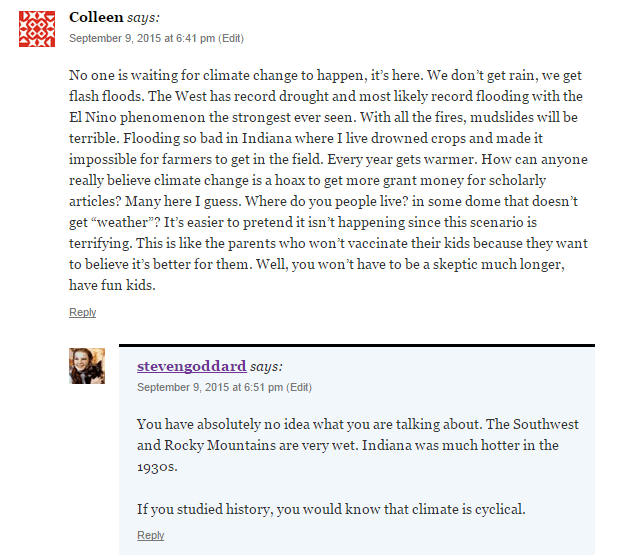
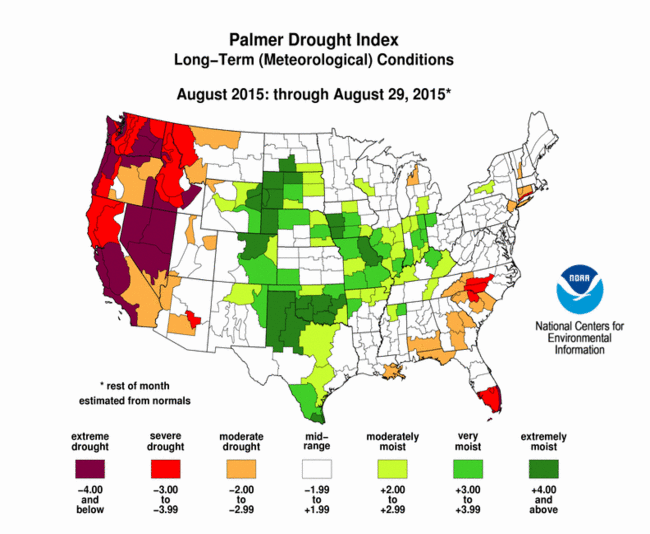
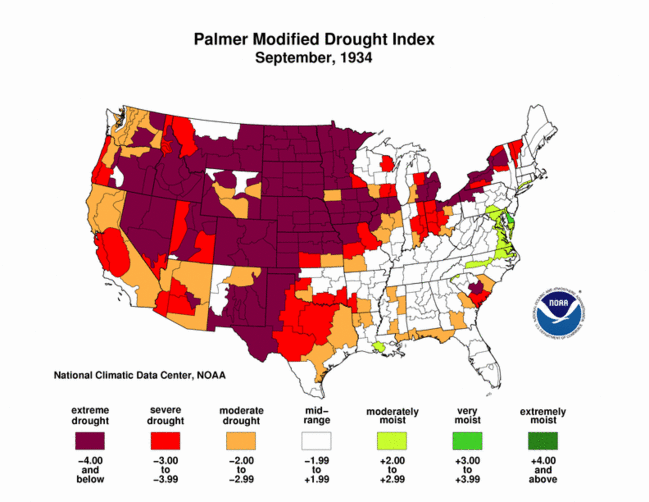
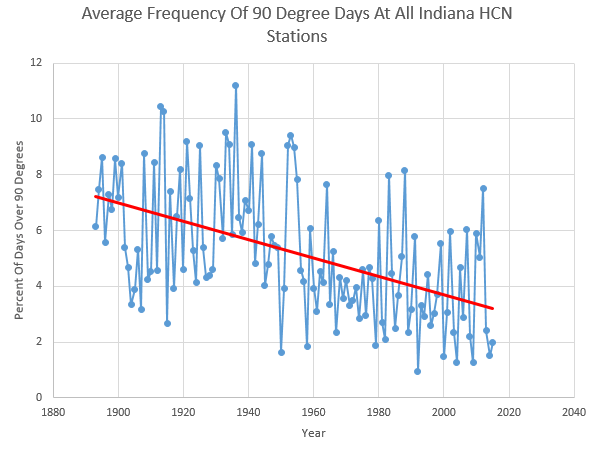
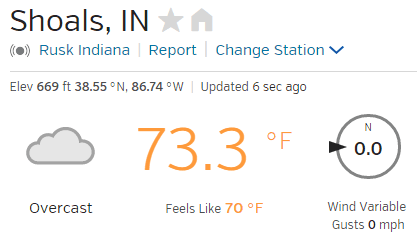

Evidence of neurosis galor in that woman’s tweet. This summer temps in Indiana were pretty mild and if she wasn’t neurotic she would know that.
rah, did you realize that Colleen just responded to Steve’s June 3, 2012 post?
Anyone been to Texas recently? Remember the claims of a “Permanent Drought” lasting to the end of this century and beyond?
Anyone calling out the Mainstream AGW Media on this???
Most of the people alive in 1933 are either very old or dead and no young people listen to them anyways.
Hard information can be safely ignored if one wishes to be willfully stupid, of course.
Poor child.
How can anyone look at 4 years of drought and think it is worse than the 180 and 240 year long droughts that started in the year 850?
Any increase in flash floods is from land use changes not increased rainfall.
When you cover the land with roads, buildings and parking lots the rain has to go somewhere. it can’t soak into the ground because it is sealed off. So it runs downstream creating flash floods. These add to the amount of normal runoff leading to flooding.
Since 2005 USCRN trend is -0.023F/year, ClimDiv trend is -0.045F/year
http://www.ncdc.noaa.gov/temp-and-precip/national-temperature-index/time-series?datasets%5B%5D=uscrn&datasets%5B%5D=climdiv¶meter=anom-tavg&time_scale=p12&begyear=2005&endyear=2015&month=8
10 years is longer that Colleen’s mind has been functional.
Gee!
Is that why the founder of the Climate Channel, who also happens to be a degreed, well-experienced meteorologist, is suing Albert Arnold Gore, Jr. – over his “Global-Warming Money Gravy Train”? ? ?
Colleen says that fires can cause mudslides.
If the destruction of surface vegetation is severe enough, it can lead to conditions ripe for mudslides – but they do not actually “cause” them.
California surface vegetation is too sparse to do anything to hold back mudslides. Entire hills slide down, trees and all. Fires don’t damage roots anyway, and new plants grow back quickly. But plants don’t hold back mudslides any better than they held back Mt. St. Helens.
The issue is not that fires burn away the roots holding the soil together. Rather, the issue is that the ground cover in California, chaparral,etc, contains lots of waxes and resins and such. In addition to fueling the fires, the waxes are vaporized and driven into the ground. When they hit cooler soil several inches down, the waxes condense, forming an impervious layer with several inches of permeable soil on top. The next rains after the fire saturate the top inches, but can’t drain into the ground because of the shallow impervious layer. Soon the runoff starts carrying the saturated layer with it, and a debris flow is formed.
I’ll write that down. Vaporized and driven into the ground several inches. Let me get my pen. Waxy impervious soil layer. Got it.
I just asked by boy scout master and he told me smoke doesn’t go into the ground. So I will have to erase that. He didn’t know about the waxy smoke, though.
Fire / Flood Cycle
Erosional Processes in Chaparral Watersheds
Erosion is a prevalent process in chaparral habitat. Slopes ranging from 25 to 70 degrees in steepness are typical in chaparral habitat (Radtke 1983). This is due to the fact that chaparral habitat is typically associated with mountain ranges which are young and geologically active. Close to 25% of chaparral watersheds exceed what is referred to as the angle of repose, or the angle between the horizontal and the maximum slope that a particular soil or other material assumes through natural process (Radtke 1983). These slopes are shaped by gravity as materials not firmly attached to the slope slide and fall unless held in place by plant materials or other factors.
The Santa Monica, San Gabriel, and San Bernadino Mountains, as well as most of the coastal ranges, are extremely young and extremely geologically active. Writer John McPhee, in his essay Los Angeles Against the Mountains, suggest that the mountains of Southern California appear to be crumbling faster than they are rising due to the steepness, nature of rock and soils associated with these ranges, and the constant battering the ranges receive from earthquakes. McPhee relates the story of a group of scientists from Spain whom after observing the rate of decay of the San Gabriel Mountains felt sorry for their local counterparts who would be out of work due the rate of disintegration on the mountain front (McPhee 1989). The fact is, most of Southern California’s mountain ranges are rising faster than they are crumbling.
Gravity, more than water or wind, may be the most important cause of erosion in chaparral habitat. On slopes steeper than the angle of repose a process known as dry creep and dry ravel occurs, which is basically the down slope movement of materials due to gravity. During dry years this process can exceed erosion rates that occur during the wettest season of the year (Radtke 1983). In parts of Southern California, the process of dry ravel, independent of fire, accounts for over half of all hillside erosion (Anderson and others, 1959; Krammes, 1965; Rice, 1974; Howard, 1982). Over 25% of the watersheds of Santa Barbara, Los Angeles, and San Bernadino Counties are effected by this process (Rice 1987). The occurrence of dry ravel is probably unknown to most people, even those that live in the wildland/urban interface, as this process occurs on steep slopes away from structures, or unobserved under a canopy of vegetation. However, the presence of dry ravel becomes apparent following a fire as the formation of riles formed by dry ravel and dry creep appear on the barren slopes of post-fire watersheds. On going studies in the California chaparral wildlands demonstrate that dry ravel and, to a lesser extent, the formation of extensive rill networks account for most of the increased sediment production following a fire (Wells, 1986). This process may even be more prominent in the post-fire environment due to creation of hydrophobic soil layers during a blaze.
Hydrophobic Chaparral Soils
During a fire temperatures at ground level may reach six to seven hundred degrees centigrade. Oils, resins, and waxy fats stored in plants and their litter are released as they vaporize due to the intense heat (McPhee 1989). Soil is a excellent insulator, and temperatures just several centimeters bellow the surface remain much cooler, allowing the vaporized substances to recondense forming what is referred to as a hydrophobic layer, a condition also known as nonwettability. This layer is impermeable and prevents water from reaching all but the first few inches of soil, but at the same time slows the process of evaporation in the root zone. The extent and depth of a hydrophobic layer will depend upon the type of soil present. In the case of clay soils, which are fairly dense, they tend to resists this condition; however, sandy and sandy loam soils appear to be far more susceptible to hydrophobic conditions (DeBano 1987). If a drop of water is placed on an pre-burn sample of sandy loam soil, the water will all but disappear. Yet, if a water is placed upon a post-burn sample, the drop will ball up and may remain there for hours. The depth at which these layers form is further the result of such factors as fire intensity, and the content of soil moisture (DeBano 1987). The firestorms of Southern California typically occur just prior to the winter rains. Water quickly saturates the thin layer of permeable soil above the hydrophobic zone not being slowed by a vegetative canopy. Slower infiltration rates result in an increased intensity of surface runoff and erosion.
Debris Flows
Post fire erosion rates may be more than 50 – 100 times greater than on a well vegetated watershed (Radtke 1983). Work by Davis (1977) suggests that many post fire flows are debris flows. In the watersheds that Davis studied he found bulking ratios in runoff ranged from 0.5% to 2.5% by volume for normal flows to 40% to 60% by volume for post fire flows. The process by which debris flows develop in the post fire environment are the acceleration of dry ravel and formation of rill networks. The rill networks develop rapidly and deliver runoff water to the stream channels where large amounts of debris, delivered by both processes, are stored (Wells, 1987). The result is a rapid mobilization of channel deposits into debris flows (Wells, 1987). These debris flows usually occur in small watersheds in response to unusually small amounts of rainfall. However, large debris flow events can occur when a extreme storm event occurs after a severe fire.
Work done by Florsheim and others (1991), following the 1985 Wheeler Fire near Santa Barbara, suggest that normal fluvial transport of these sediments is more likely, and moderate storm events that could mobilize sediments are far more likely to occur than large magnitude, high intensity storm events that would generate large destructive flows. In any event, what is clear is that the post fire landscape is subject to significantly increased erosion rates capable of producing large destructive debris flows. Increased post fire erosion rates can be expected for a period of 8-10 years. During this recovery erosion rates might be 9 to 10 times greater than those before burning.
Post Fire Landslides
Most chaparral in Southern California grows on geologically young mountains where the steep slopes range from 25 degrees to 70 degrees (Radtke 1983). About 25 percent of the chaparral watershed exceeds the angle of repose, that is the angle between the horizontal and the maximum slope that a particular soil or other material assumes through natural processes.(Radtke 1983). On vegetated slopes anchored by deep rooted plants the angles of repose can be much steeper. Specific factors that can cause or contribute to landslides are; 1) weakness of the slope material; 2) steep or undermined slopes; 3) unfavorable geologic structural conditions; 4) prolonged precipitation; 5) absence or sparsity of vegetative cover; and 6) ground shaking (Gray 1985). Landslide occurrences in the chaparral landscape are strongly related to the angle of repose for different soils , taking into account cover, root depth, and root strength. Soils slips and landslides account for almost 50% of the total erosion in a watershed (Radtke 1982). Unlike dry creep, these soil movements normally occur when the soil is saturated. Although hydrophobic soils, dry ravel and formation of rills and the debris flows associated with these processes account for the majority of post fire erosion, landsliding activity may also increase as a result of fire.
Increases in landslides during the rainy period following a fire could be caused by well-spaced storms that permeate the nonwettable layer and completely recharge the water holding capacity of the soil (Radtke 1983). Once the soil moisture is recharged, a high intensity storm could quickly supersaturate the soil, thereby accelerating wet creep, starting slumps slides, and greatly increasing overland flow (Radtke, 1983). However, post fire landsliding during the first few years following a fire may be greatly reduced on nonwettable soils if high intensity storms follow each other in close order, thereby reducing rainfall penetration through the nonwettable layer. The soil below the nonwettable layer would remain dry, eliminating landslides, but greatly increased overland flow would result in highly visible rill and gully erosion and would increase channel scour (Radtke, 1983).
Another possible contributing factor to increased landsliding in the post fire environment is stream channel scour and erosion. This process may remove or over stepped the channel banks contributing to landsliding of over steepened slopes along the creek channel, or possible reactivate previous landslides by removing the toe of the slide.
http://www.coastal.ca.gov/fire/ucsbfire.html
* * Fires don’t damage roots anyway, and new plants grow back quickly. * *
Please read me reply again, MORE CAREFULLY this time! If you are during a dry season, most of the vegetation (like annuals, etc.) are not going to grow the fastest, and therefore, when burned – will leave behind ash instead of the leftover foliage that would have helped slow down the flows of surface rainwater. – I live very close to prairies that have very little Sagebrush and other shrubbery because of the regular (annual) occurrences of “brushfires”. Instead, the grasses and other annuals (and some herbacious perennials) act more as tinder for successive “brushfires”, and burn very quickly. Thus, during a Summer season, the ground can be left relatively bare of most of the brush and dried vegetation to slow down running surface water. The effect would be felt even greater on hillsides and mountainous areas. – We have fires every year here because of the normally dry conditions. Some years see longer “fire seasons” because lack of rainfall/snowfall during those drier years. What’s more, we do have occasions where a burned out area can (and often DOES) experience mudslides, etc. after fairly heavy rainfall AFTER the vegetation was burned off, especially if most of the surface (ground) was primarily smooth soil or even sandy composition. The surface vegetation DOES serve as a means to help prevent most of the immediate erosion of surface soil when there are heavier periods of precipitation.
– Commonsense!
i imagine that having multiple active faults interlaced through out a great deal of the state doesn’t do anything to help matters either. Always amazed me how people build homes of the sides of unstable hills and then are surprised when the lose their home to a slide. Or they build their homes in a woods in naturally arid country and wonder how come a fire took it. Or they build their homes on a beach where hurricanes strike and then wonder how they could be so unlucky as to have it all blown or washed away. Or they build their homes in the flood plain of the Mississippi River or any other major River while relying on man made dykes and berms to protect them and then wonder why those protective measures didn’t work when it is well known that large channelized rivers cannot be controlled all the time. That’s why there are meanders and the 100s of Oxbow lakes or remnants there of visible. Hell, even the ancients understood that if your going to live next to a big river you better build a big ass mound to live on or retreat to.
And think about that! The government can’t control the large rivers in this country but some people believe that same government has the power to effect the global climate?
My guess is that “Colleen” never heard of the Great American Dustbowl Days? ? ?
Seems we have not yet had another equally devastating naturally-occurring draught of this magnitude. There again, there are many today who have very little knowledge of true history as it really happened.
What’s more,
In my area, it seems that Fall has made its effects know a few weeks earlier this year. Not only that, but the last couple of Winters have seen longer spells of colder temperatures, to include some long-forgotten sub-zero temperatures. Hmmm! Wish it were actually warming more here!
* * Any increase in flash floods is from land use changes not increased rainfall.
When you cover the land with roads, buildings and parking lots the rain has to go somewhere. it can’t soak into the ground because it is sealed off. So it runs downstream creating flash floods. These add to the amount of normal runoff leading to flooding. * *
Well said, “Myron”!
These chicken-littles also seem to forget the role of vegetation and their actions which happen to help slow down the erosion of soil as well as slow down the flow of above-surface running water. Here, they habitually mix apples and oranges when talking about terrain’s effects on rain runoff and the weather in general. What they also forget are the effect of “micro-climates” that are isolated to a specific geological (and topographical) area. These micro-climates usually do not extend beyond what the area topography will allow to pass, because the micro-climate effect is not felt very high into the ionosphere, but are lower-elevation effects. Hmmm! Guess folks like “Colleen” did not study topography and climate’s relationship to, either? ? ?
Then,
The last fifteen-hundred to twenty-five-hundred weather and climate cycles also routinely get ignored, even though there is some information from some of the past cultures who had developed writing systems to record their experiences with the climate and weather then. We also have the historic knowledge of what happened to certain cultures when their farming and general agriculture failed, all due to extreme changes in their climates – LONG BEFORE THERE EVER WERE ANY STEAM ENGINES, COMBUSTION ENGINES, AND ANY WIDESPREAD USE OF COMBUSTION-BASED TECHNOLOGY! Again, folks like “Colleen” would never let a few known facts get in the way of telling a good, frightful tale to everyone!
“devastating naturally-occurring draught” ????
That would be a hurricane, right! 😉
Just picking on your typo… sorry ! 🙂
Okay, “mummy”.
I think I have a working definition of “Climate Change” as understood by the CAGW cargo cult members:
“Climate change” is any weather that I don’t remember experiencing last year.
….b
You must forgive her, she obviously gets her information from the LSM. Any fact checking on her part is way beyond her skill set. Rather sad in fact….
I got the impression she lives in Indiana. Thus she personally experienced this last summer. As a 60 y/o born and bred Hoosier I’m saying the woman is necrotic because this last summer was mild here compared to many in the past I experienced. I think she is one of the many that nothing better to do than actively look for things to worry about and gossip about them. A real chicken little.
She demonstrates the cleverness of the propaganda machine Stalin put in place after nations and national academies of sciences were united on 24 October 1945:
Standard Climate Model
Standard Nuclear Model
Standard Solar Model
Big Bang Cosmology
Share a common purpose: To forbid public knowledge of the source of energy that heats planet Earth and sustains our lives powers: NEUTRON REPULSION
https://www.researchgate.net/publication/280133563_Solar_Energy
Any person with even a basic grasp of physics is invited and encouraged to read the above paper and then post their reasons for affirming or denying:
1. Dr. Carl von Weizsacker’s nuclear binding energy concept is flawed in exaggerating the repulsive forces between protons and ignoring the repulsive forces between neutrons
2. Neutron repulsion is the main source of energy in cores of
_ a.) Heavy atoms like Uranium
_ b.) Some planets like Jupiter
_ c.) Ordinary stars like the Sun
_ d.) Galaxies like the Milky Way
_ e.) The now expanding Cosmos
She’s probably pretty young. She also suffers from a condition that many young females have. She has bought into the idea that big daddy government is her surrogate father. Big daddy govt can fix the weather, which would be naturally always perfectly benign if not for the evil of capitalism.
Physics became Stalin’s favorite weapon of fear after WWII:
https://www.yahoo.com/finance/news/scientists-built-most-powerful-physics-182927605.html
If you just consume the Kool Aid, don’t personally delve into the subject and are too lazy to learn something about past weather/climate, you are nothing more than a useful idiot. You are simply regurgitating talking points and highly politicized propaganda, spewed by those who want to regulate and micromanage every aspect of your life and take away whatever freedom we still have left. All based on a scientifically very flimsy notion that the planet is in some type of immediate peril, from heating that is simply not taking place..
I have a suggestion to help with this problem.
Since we are supposed to have a government of the people,by the people and for the people. perhaps the government should listen to the people instead of talking so much?
I propose that for one week each month the government be instructed by law to make no press releases, announcements or public comments to the people, but only respond privately in direct answer to individual citizens questions. 🙂
NOPE! Bad idea. They would just use that time to get away with everything they could and then at the end there would be one big news dump that nobody would want to sift through. Better Idea would be to cut the government by at least half. Then there would be a lot less people talking.
You mean cut it by half every year until they can hear us and we can understand what they are saying?
Hell Colorado, at this point I would be happy with just getting rid of 1/2 of the IRS.
rah, I take it back. It won’t work. We haven’t asked ourselves the fundamental question:
What is the role of the federal government?
I thought I remembered that the constitution touched on the subject but Joe Davidson *) from the Washington Post says it’s not that simple. I must have misunderstood something. I have to go back and study.